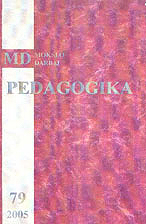Lietuvos ir Šiaulių miesto bendrojo lavinimo mokyklų tinklo pertvarkos aktualijos
Topicalities of the Reorganization of Lithuanian and Šiauliai Comprehenisive Schools Network
Author(s): Edita Minkuvienė, Teodoras TamošiūnasSubject(s): Education
Published by: Vytauto Didžiojo Universitetas
Keywords: the restructure of educational system; main types of schools: basic school; secondary school and gymnasium; the indicators of school teachers' qualification.
Summary/Abstract: 1999 benchmarks of the reorganization of general education institutions network determined the tendencies of the reorganization of Lithuanian education system. The following two stages are characteristic of the process of the reorganization of schools network: 1) 1999–2005 – the reorganization of primary and basic schools network switching to decennial basic and profile teaching at secondary education schools, 2) 2005–2010 – the purification of all types of comprehensive education institutions and their coordination interdependently according to the intended structure. Since from 2006 onwards the programme of secondary education will be implemented only at gymnasiums and professional schools, the reorganization of secondary school into a basic school or gymnasium is intended in the project of Strategic Provisions for Lithuanian Education Development for 2003–2012. This document validated a three-stage Lithuanian comprehensive education structure (primary school, basic school, gymnasium), the elements of which may join into associated formations. Statistic data of the reports of 2001–2004 summaries of Lithuanian and Šiauliai comprehensive schools were united during the research. It has been estimated that: 1) The number of pupils at national comprehensive schools kept decreasing; however, in 2004–2005 school year the increase of the number of pupils was distinct; 2) Due to a rapid reorganization of national secondary schools into basic schools, the number of pupils kept increasing apace at national basic schools in 2001–2004; 3) The prevailing hundredth of 1–8 class pupils at national basic schools is 81–90%, at secondary schools – 61–70%, and at gymnasiums – 41–50%; 4) The concentration of 9–12 class pupils reaches 35–41% at national secondary schools; 5) The dominant of the number of 1–8 class pupils constitutes 62,5% at Šiauliai secondary schools; 6) The relative value of 1–8 class pupils is 85% at town basic schools; 7) The dominant of the number of 9–12 class pupils constitutes 60 % at town gymnasiums.
Journal: Pedagogika
- Issue Year: 2005
- Issue No: 79
- Page Range: 103-109
- Page Count: 6
- Language: Lithuanian

